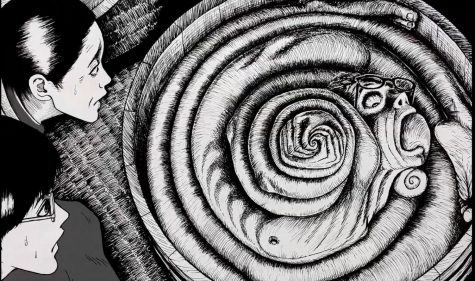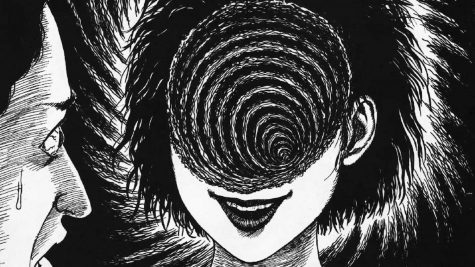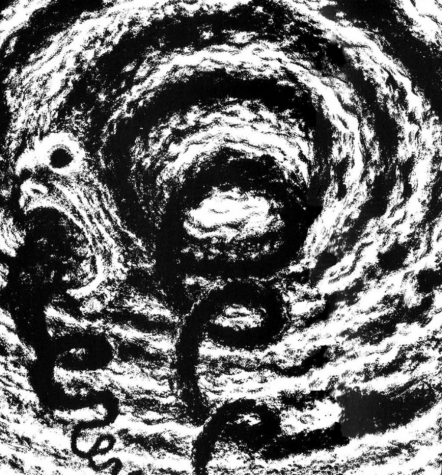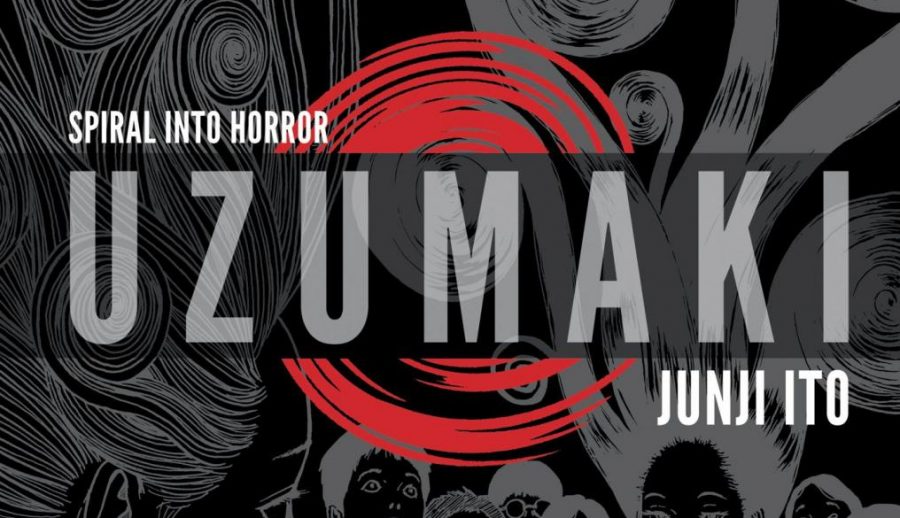Review: The horror of Junji Ito’s Uzumaki
It started with an obsession. We, the reader, follow Kirie Goshima, the protagonist, encountering a man crouched down in an alleyway and staring at a wall. She believes this distracted fellow is the father of her boyfriend, Suichi Saito. Kirie curiously peers her head to see what this man is entranced by and sees the engraving of a spiral. At first, she concludes that this is not the same person. Then, Suichi stresses to her about his father’s strange behavior recently: swirling his soup to make a whirlpool right before he dines, purchasing pieces that look like spirals and even plastering spirals across the walls of their home. Writing this off as just a quirky hobby, Kirie doesn’t think much of this. She then realizes the terror of that obsession when she encounters Suichi’s father. The first time he horridly started spinning his right and left eye independently of each other and second, when he inhumanly stretches out his tongue and makes it painfully curl endlessly with drool seeping from the organ. Proclaiming that he can “call the spiral” from within. This is only the first half of the first chapter in written form from the manga Uzumaki, as Japanese horror mangaka Junji Ito takes the reader on a trip to the fictional city of Kurouzu-cho, Japan with its citizens facing a supernatural curse and growing infestation of spirals.

Uzumaki is written and drawn by Junji Ito and released from January 1998 to August 1999. The English translation is sold by VIZ Media LLC and was published in 2013. For decades, Uzumaki has been praised for its terrifying imagery as Ito’s utilization of body horror and depictions of insanity are beautifully portrayed through his art. But what makes Uzumaki an amazing read is the concepts and themes Ito explores in the curse itself. Even with the release of Uzumaki dating back several decades, Ito’s story still has prevalence and popularity in the today’s pop culture sphere. Adult Swim announced the manga will receive an anime adaptation which is slated to release in October 2022. What makes this announcement even more interesting is the anime’s art direction, opting to stylize in black and white to be in match Ito’s style of line work. Canadian American saxophonist Colin Stetson, who composed the soundtrack to the 2018 film Hereditary, will also create the score for the anime. But what makes Uzumaki scary?
Like in his other works: Remina, Hanging Balloons and Enigma of Amigara Fault; some of Ito’s stories portray a fear of the inevitable with his characters facing an uncontrollable force of nature. In his panels Ito draws grand terrors with subtle to insane character expressions to make the reader awed yet uncomfortable. In Uzumaki, the story exploration of that inevitability has more effect when exploring the shape of a spiral. When drawing a spiral, there are two ways to form its shape, either from the outside or the inside. Drawing or perceiving a spiral in either way is dependent on how someone would first look at it, either from the inside, where it ends, or the outside where it has no stoppage point. What Uzumaki portrays from this is idea is the fear of the inevitable with the fear of endless torture. There are instances townspeople meet terrible fates through an anthology-like story piece, then there’s the continuous cycle of terror through the curse portrayed in how constant people willingly or unwillingly submit to the curse.

Ito utilizes his horror in the form of spectacle. In the story the spirals have no reason for haunting Kurouzu-cho or pattern of their punishment, thus giving this godly essence that reach Lovecraftian levels of cosmic horror. In Uzumaki, the characters cannot battle or escape this curse, only further submit to its unusual punishments. But spectacle horror can work like a double-edged sword, with the grand scenes that take up the panels, proper characterization doesn’t. For example, while we do follow Kirie in the story, she feels easily replaceable due to how basic she is written as she serves only being the reader’s perspective. Apart from her and Suichi, who serves to fit the pocket of being the only knowledgeable one in the story, no other character’s names are memorable, only what happens to them is. Though those criticisms are highly subsided when realizing Ito didn’t intented to make compelling characters but creative situations, and the terrors the spirals cause are nothing but.

Uzumaki is classic horror at its most abstract. It’s a story filled with gruesome imagery with every page turn and by the end, leaves the reader in an uncomfortable state of mind and possibly a phobia with spirals. This manga should be a necessary in any horror fan’s collection. Ito has many amazing works under his belt, but Uzumaki holds the title that should be considered the mangaka’s magnum opus.

Luis Rios is a senior entering his fourth year at The Round Up and his second year as Political Writer. As he works towards completing his major in Journalism...











